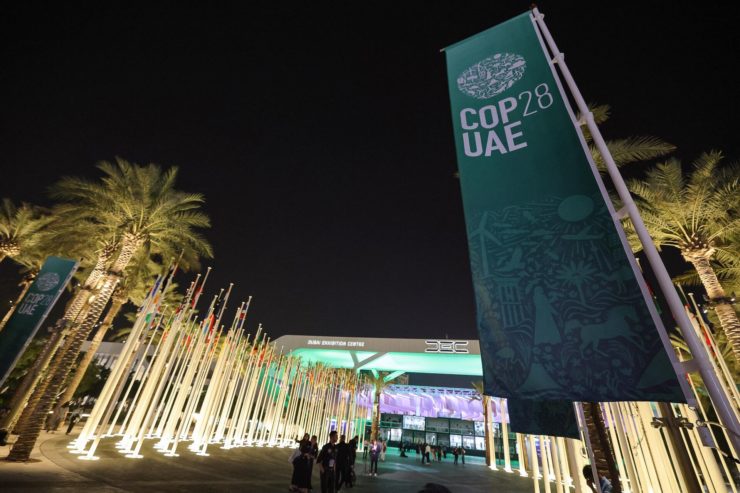
Within the framework of the 28th Conference of the Parties to the United Nations Framework Convention on Climate Change (COP28) held in Dubai, the Russian company Rosatom held a Small Modular Reactors Day.
The CEO of Monatom, a Mongolian state-owned company engaged in the promising development of a new industry for Mongolia, took a very active part in the event. During the SMR day, Rosatom representatives familiarized him with the concept of a low-capacity nuclear power plant concept for Mongolia. Following the event, the parties signed a memorandum on the construction of a low-capacity nuclear power plant in Mongolia by Rosatom, thus officially launching negotiations on the project. In addition to Monatom, a cooperation agreement with the Russian company was signed by Dayan Deerkh Energy, which is also interested in developing nuclear, wind and hydropower projects.
Prospects for the SMR creation based on the Russian project were discussed by the two countries even before COP28. In particular, back in early 2023. Rosatom signed a Memorandum of Understanding on cooperation in the field of peaceful uses of atomic energy with the Mongolian Nuclear Energy Commission. Already in June this year, at SPIEF-2023, Rusatom International Network and the aforementioned Dayan Daerkh Energy also signed a declaration of strategic cooperation. The topic of creating a low-capacity NPP was raised at the highest level during the regular meeting of the Russian Mongolian Intergovernmental Commission held in October 2023. In the course of the meeting, the Russian side proposed to Mongolia the realization of such a project. Even earlier, during negotiations between Badrakh Energy, Mongolian company, and the French Orano Group on the development of uranium deposits in Mongolia, the CEO communicated to his French colleagues about his country’s interest in building a low-capacity nuclear power plant.
Despite the fact that this topic has been developed in 2023, the prospects for the use of nuclear energy in general have been studied in Mongolia since the 1960s – it is since that time that the Nuclear Energy Commission has existed in the country. The topic of NPP creation is also not new for the Mongolian civil and expert society. There are a number of publications on this topic in the Internet as far back as 2000s-2010s. However, the process has now moved forward because of Rosatom’s significant progress in promoting low-capacity NPPs. This year the company received a license to build the first non-experimental NPP of this type in Yakutia. In the past, for a small country like Mongolia, the cost of establishing one station was close to half of the country’s entire annual GDP, but now the SRM development opens up new finance-raising opportunities for the country.
During COP28 itself, Mongolia acceded to an official document related to NPPs, which was signed by a number of countries participating in the forum. The declaration fixes the aspiration of different countries of the world to increase electricity generation at nuclear power plants by three times by 2050. This measure is considered as one of the means to achieve carbon neutrality.
At the same time, Mongolia is currently still very far from the benchmarks of international climate and environmental agreements. The overwhelming share of all electricity in the country is generated by coal-fired thermal power plants built by Soviet specialists. Most of them have been in need of repair and reconstruction for a long time, for which considerable funds are currently going from the Mongolian budget.
Mongolia has few alternatives to cheap coal, which is abundant in the country. Its attempts to switch to hydropower have met with resistance from its northern neighbor, the Russian Federation, which, in particular, has stated that the construction of the largest hydroelectric project in Mongolia, the Egiin Gol hydropower plant, could pose a possible environmental threat to the Baikal region. Currently, only the Erdeneburen HPP project and Taishir HPP are promoted in this industry. Solar and wind power are quite actively developing in the country, but the energy they produce is intermittent and expensive.
The results of the energy sector development in Mongolia over the past decade are such that the energy self-sufficiency goal set out in the National Security Concept of Mongolia in 2010 is still relevant; since the Concept was adopted, the share of imported electricity in total consumption has increased from 15 to more than 20 percent. And by 2035, the country’s Department of Energy estimates that the Mongolian electricity consumption will increase 2.5 times…
By the way, 13 years ago, the same Concept mentioned uranium along with water resources, oil and coal as a promising domestic raw material for the development of Mongolian energy. This year, the attractiveness of a nuclear energy alternative for Mongolia has grown even stronger in terms of the availability of its main fuel: due to significant progress on a deal with Orano Group, France, to develop three large uranium deposits in the country.
Thus, the agreement between Rosatom and Monatom launched the complex process of nuclear power development in Mongolia. Ahead, there is certainly a public consultation of the project, discussion of the terms of reference and justification, and negotiations on the terms of financing the project. There is also a dependence of this project on the progress of new Mongolian-French uranium mining projects. Nevertheless, it is now, at the end of 2023, that this topic has become the object of substantive discussion between the authorities and companies of the two countries – discussion of already quite real projects and plans, rather than opportunities and prospects. And that’s nothing short of rewarding.
Boris Kushkhov, the Department for Korea and Mongolia at the Institute of Oriental Studies of the Russian Academy of Sciences, exclusively for the online magazine “New Eastern Outlook”.